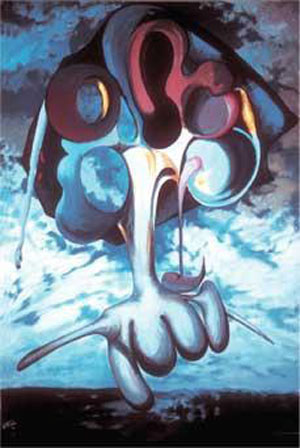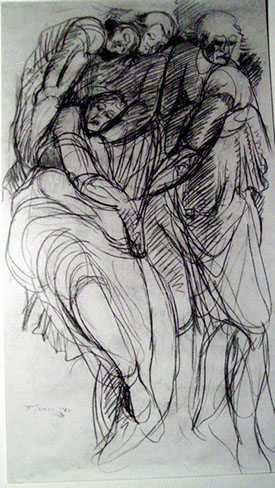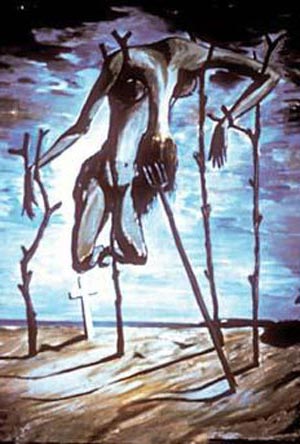

At 7:30 PM on December 19th, 1961, Governor-General of Portuguese India, Gen. Vassalo e Silva, formally surrendered Goa to India, ending 451 years of Portuguese control of this legendary territory. The battle had lasted less than 40 hours.Tribute from Alex Tavares' first one-man Nairobi exhibition Just days before the final battle for Goa, Alex Tavares attempted to pay a visit to the General, who earlier that year had opened the 27-year old artist's first one-man exhibition at the home of Dr. Leao Pinto. Tavares believed Goa to possess the unique culture and traditions; distinct languages; the spiritual diversity and strength; the agricultural and economic potential; and especially the creative spirit to forge its own success as a nation; and sought to convey this message to Gen. Silva. Security guards turned him away at the gates of the Governor's Palace; and Goa would be surrendered days later. Tavares stayed amidst the turmoil for another 18 months, leaving for East Africa in 1963. He has since returned only through his thoughts, visions and memories. This exile has been the muse for much of his awe-inspiring collection of paintings in the Surrealist tradition and other styles, drawings, sculptures and prints. Alex Joseph Tavares was born on the island of Zanzibar, off the east coast of Africa, on April 9th. At the time, Zanzibar was a British protectorate with a rich and dark history of its own. it would unite with the mainland territory of Tanganyika as the new nation of Tanzania in 1964. His mother's most vivid recollection of his early childhood was of pushing her son along a tropical beach in a pram carriage and meeting a fortune teller, who gazed into the youngster's intense countenance and predicted greatness. In 1938, as rumblings grew of a German invasion of Zanzibar, the Tavares family moved to its ancestral home of Goa, the capital of Portuguese India. Tavares' mother tongue is Konkani, a Sanskrit descendent and official language of Goa. The Goans have bravely maintained their culture through centuries of political turmoil, creating a strong literary and creative identity of which Alex Tavares can certainly be considered a torchbearer. Tavares was a young artist when India gained independence from Britain in 1947. This historic freedom was the catalyst for political, social, cultural and religious controversy across India; his development as an artist in this milieu explain an almost encyclopedic knowledge of both religious imagery--and other artists' interpretations of those themes. Three years later, in 1950, Tavares started a five-year course at St. Joseph's Technical School in Madras, India. Here, he studied under renowned Spanish artist Juan Monzan. He finished his studies a year ahead of schedule, creating monumental wood sculptures for churches in Madras, Guntur and Bangalore during this time. Upon graduation, he followed the masters who inspired him by beginning his teaching career at St. Joseph's. In 1958, he was awarded a scholarship to Escuelas Professionales in Barcelona, Spain. Here in the spiritual home of Surrealism, he also studied drawing at La Academia des Bellas Artes, a cradle of artists that counts three of the 20th century's greatest masters--Pablo Picasso, Salvador Dali and Juan Miro--among its alumni. He received commissions for his sculptures in Brazil and Argentina during his studies. In 1960, Tavares received his diploma in Sculpture, Painting and Woodcarving; after completing a commission for Colegio San Miguel in Madrid, he traveled across Europe visiting museums and galleries. He came to Kenya for the first time, by ship from Rome to Mombasa, in 1960, reuniting with his family for the first time since leaving for Madras a decade earlier. He returned to Goa, and the most dramatic crossroads of his life, for the last time in 1961. Tavares arrived in Nairobi in 1963, just before Kenya gained its independence from Britain. Nairobi was a thriving, cosmopolitan city, home to thousands of native Goans; whose diaspora for a nation so small is astoundingly global. After four months, he found a job as a colour consultant for a paint company. He sculpted and painted in his own time, a refuge for the pain of his personal exile from Goa. An early Nairobi breakthrough came when he won a street decorating competition that was part of Kenyan independence celebrations. Soon, he began exhibited in group shows, creating a spectacular buzz in Nairobi's flourishing art scene. While wildlife and tribal symbolism dominated the work of many of his East African contemporaries, Tavares shone as a "monumental painter of ideas," in the words of E.P. Njau. His complex and often shocking sociopolitical commentaries were recognized for their unique, classically inspired brilliance. In 1965, Tavares unveiled his first Nairobi one-man exhibition at Chemchemi Cultural Centre, sponsored by the Fairfield Foundation of New York City; "chemchemi" is Swahili for "source" or "wellspring". Legendary journalist, novelist and academic Ezekial (Es'kia) Mphahlele--one of South Africa's most important artistic voices in the struggle against apartheid--curated this landmark exhibition. Wilfred R. Maciel paid homage to his friend's artistic integrity in a tribute which appeared on the Chemchemi program: "Living in India, in Spain and in East Africa has its advantages. The observations of tensions are universal and necessarily deserve to be depicted as such. It is not the glamour of society. It is not the comfortable existence of a bourgeoisie that interests Alex. He is a man with a mission." "People from different walks of life in the city have flocked to see this show. It is as if an elephant has come to town for the first time!" wrote E.P. Njau in his 1967 review of Tavares' one-man exhibit at Paa-ya-paa Art Centre, Njau's legendary Nairobi gallery. Tavares would also enjoy an acclaimed run there the following year. "But why such a big crowd at this particular show? Is it because Tavares' paintings communicate more to people than has been the case with most artists' work?" "Paa-ya-Paa" means "the antelope rises" and is a symbol of new "creative adventures." As a gallery it "seeks to be 'just a place' away from lecture halls andaway from experts, a place where creative ideas and thoughts may flourish and flow freely between persons in the spirit of equality and in a relaxed and casual atmosphere..." - Njau The Gallery would be tragically destroyed in a 1997 fire. Njau was seriously burned and partially blinded trying to rescue his priceless collection. Alex Tavares arrived in Arcola, Saskatchewan in February of 1969--in the middle of the fierce, unfamiliar Canadian Prairie winter. His work, which he had shipped by container, arrived intact from Nairobi. Tavares had a prolific year artistically despite having uprooted his life halfway around the world. Tavares would stay only a few months in Saskatchewan, long enough to inspire a great deal of praise and passionate debate with an exhibition at Regina's Central Public Library. This exhibition of paintings--described by a local art writer as "the most disturbing to hang on the gallery's walls in recent years"--would be the subject of a CBC News Feature. Since moving to Toronto, his art has been largely focused on human abuse of the environment, a vision manifested most notably the Drape Series. Inspired by the original idea of capturing on film the falling of huge draperies dropped from a plane, this Series has been evolving for over 30 years and has since spawned numerous related extensions such as Drape Figures. The Ozone Memo series is another such concept of environmental commentaries. Upon arrival in Toronto, Tavares began building his profile by exhibiting in libraries across the city. In 1971, he traveled to London, England to exhibit at the prestigious Zella 9 Gallery. The Picture Loan Gallery was the scene of his Toronto one-man debut in 1972. Gallerygoers and critics admired The Drape Series' juxtaposition of subtle forms onto an epic scale execution. In 1986, Ontario Minister for Citizenship and Culture Lily Munro opened his 25-year Retrospective at the Wexford Art Centre in Toronto. He has since exhibited internationally in China, Japan, New Zealand, Mexico, and St. Kitts. In 2000, Tavares began work on his Millennium Series, which would take shape over a two-year period. This newest series is a unique expression of his personal feelings and reactions of society to the biggest chronological milestone of our time. Today, he continues to draw, paint, and create in the brand new studio of his Toronto home--inspired by the prospect of this renaissance in the twilight of his brilliant career, a reckoning with exile. by Sebastian Cook
Click here for the selected Web listing PDF of Alex's
one-man exhibitions, dating back to 1961.
|
   |
|